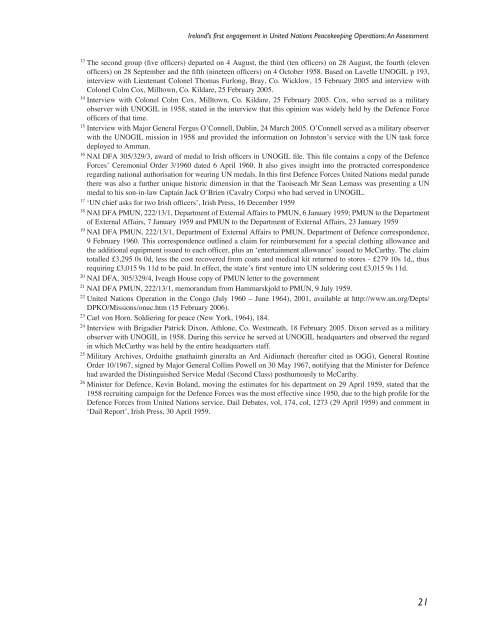Defence Forces Review 2008
Defence Forces Review 2008
Defence Forces Review 2008
You also want an ePaper? Increase the reach of your titles
YUMPU automatically turns print PDFs into web optimized ePapers that Google loves.
Ireland’s first engagement in United Nations Peacekeeping Operations: An Assessment<br />
13<br />
The second group (five officers) departed on 4 August, the third (ten officers) on 28 August, the fourth (eleven<br />
officers) on 28 September and the fifth (nineteen officers) on 4 October 1958. Based on Lavelle UNOGIL p 193,<br />
interview with Lieutenant Colonel Thomas Furlong, Bray, Co. Wicklow, 15 February 2005 and interview with<br />
Colonel Colm Cox, Milltown, Co. Kildare, 25 February 2005.<br />
14<br />
Interview with Colonel Colm Cox, Milltown, Co. Kildare, 25 February 2005. Cox, who served as a military<br />
observer with UNOGIL in 1958, stated in the interview that this opinion was widely held by the <strong>Defence</strong> Force<br />
officers of that time.<br />
15<br />
Interview with Major General Fergus O’Connell, Dublin, 24 March 2005. O’Connell served as a military observer<br />
with the UNOGIL mission in 1958 and provided the information on Johnston’s service with the UN task force<br />
deployed to Amman.<br />
16 NAI DFA 305/329/3, award of medal to Irish officers in UNOGIL file. This file contains a copy of the <strong>Defence</strong><br />
<strong>Forces</strong>’ Ceremonial Order 3/1960 dated 6 April 1960. It also gives insight into the protracted correspondence<br />
regarding national authorisation for wearing UN medals. In this first <strong>Defence</strong> <strong>Forces</strong> United Nations medal parade<br />
there was also a further unique historic dimension in that the Taoiseach Mr Sean Lemass was presenting a UN<br />
medal to his son-in-law Captain Jack O’Brien (Cavalry Corps) who had served in UNOGIL.<br />
17<br />
‘UN chief asks for two Irish officers’, Irish Press, 16 December 1959<br />
18 NAI DFA PMUN, 222/13/1, Department of External Affairs to PMUN, 6 January 1959; PMUN to the Department<br />
of External Affairs, 7 January 1959 and PMUN to the Department of External Affairs, 23 January 1959<br />
19<br />
NAI DFA PMUN, 222/13/1, Department of External Affairs to PMUN, Department of <strong>Defence</strong> correspondence,<br />
9 February 1960. This correspondence outlined a claim for reimbursement for a special clothing allowance and<br />
the additional equipment issued to each officer, plus an ‘entertainment allowance’ issued to McCarthy. The claim<br />
totalled £3,295 0s 0d, less the cost recovered from coats and medical kit returned to stores - £279 10s 1d,, thus<br />
requiring £3,015 9s 11d to be paid. In effect, the state’s first venture into UN soldering cost £3,015 9s 11d.<br />
20<br />
NAI DFA, 305/329/4, Iveagh House copy of PMUN letter to the government<br />
21<br />
NAI DFA PMUN, 222/13/1, memorandum from Hammarskjold to PMUN, 9 July 1959.<br />
22<br />
United Nations Operation in the Congo (July 1960 – June 1964), 2001, available at http://www.un.org/Depts/<br />
DPKO/Missions/onuc.htm (15 February 2006).<br />
23<br />
Carl von Horn. Soldiering for peace (New York, 1964), 184.<br />
24 Interview with Brigadier Patrick Dixon, Athlone, Co. Westmeath, 18 February 2005. Dixon served as a military<br />
observer with UNOGIL in 1958. During this service he served at UNOGIL headquarters and observed the regard<br />
in which McCarthy was held by the entire headquarters staff.<br />
25<br />
Military Archives, Orduithe gnathaimh gineralta an Ard Aidiunach (hereafter cited as OGG), General Routine<br />
Order 10/1967, signed by Major General Collins Powell on 30 May 1967, notifying that the Minister for <strong>Defence</strong><br />
had awarded the Distinguished Service Medal (Second Class) posthumously to McCarthy.<br />
26<br />
Minister for <strong>Defence</strong>, Kevin Boland, moving the estimates for his department on 29 April 1959, stated that the<br />
1958 recruiting campaign for the <strong>Defence</strong> <strong>Forces</strong> was the most effective since 1950, due to the high profile for the<br />
<strong>Defence</strong> <strong>Forces</strong> from United Nations service, Dail Debates, vol, 174, col, 1273 (29 April 1959) and comment in<br />
‘Dail Report’, Irish Press, 30 April 1959.<br />
21
















